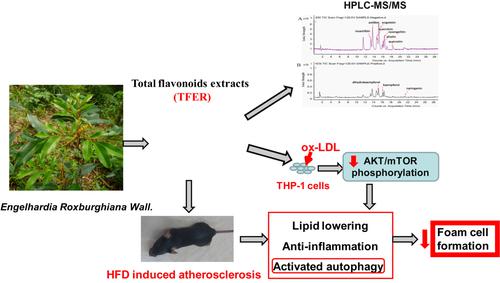当前位置:
X-MOL 学术
›
Chem. Biodivers.
›
论文详情
Our official English website, www.x-mol.net, welcomes your
feedback! (Note: you will need to create a separate account there.)
Total Flavonoids of Engelhardia roxburghiana Wall. Leaves Alleviated Foam Cells Formation through AKT/mTOR-Mediated Autophagy in the Progression of Atherosclerosis
Chemistry & Biodiversity ( IF 2.3 ) Pub Date : 2021-07-14 , DOI: 10.1002/cbdv.202100308 Jie Wei 1 , Liangliang Huang 2 , Dongmei Li 1 , Junhui He 1 , Yanjing Li 3 , Fei He 1 , Weirong Fang 2 , Guining Wei 1
Chemistry & Biodiversity ( IF 2.3 ) Pub Date : 2021-07-14 , DOI: 10.1002/cbdv.202100308 Jie Wei 1 , Liangliang Huang 2 , Dongmei Li 1 , Junhui He 1 , Yanjing Li 3 , Fei He 1 , Weirong Fang 2 , Guining Wei 1
Affiliation

|
Engelhardia roxburghiana Wall. is a traditional Chinese medicine used for treating cardiovascular diseases. Our previous study has implicated potential effects of total flavonoids of Engelhardia roxburghiana Wall. (TFER) against hyperlipidemia. The aim of the study is to uncover the effects and underlying mechanisms of TFER on foam cells formation after atherosclerosis. We used high fat diet (HFD) induced Apoe-/- mice and oxidized density lipoprotein (ox-LDL) induced THP-1 cells to mimic process of atherosclerosis in vivo and in vitro, respectively. Lipid accumulation, inflammation response, autophagosomes formation and expressions of autophagy related target genes were assessed. Our present study demonstrated TFER (500 mg/kg) alleviated macrophage infiltration and lipid accumulation in thoracic aortas of HFD-treated mice. In ox-LDL-treated THP-1 cells, MDC staining and Western blot analysis all indicated that the TFER (200 μg/ml) reduced foam cells formation and IL-1β releasing, activated autophagy through suppressing AKT/mTOR signaling, significantly regulating expressions of AKT, p-AKT, mTOR, p-mTOR, Beclin 1, LC3-II, p62. It is suggested that TFER alleviated atherosclerosis progression in vivo and in vitro through reducing foam cells formation and inflammatory responses, and the possible mechanism may be due to the activation of macrophage autophagy by inhibiting AKT and mTOR phosphorylation.
中文翻译:

Engelhardia roxburghiana Wall 的总黄酮类化合物。在动脉粥样硬化的进程中,通过 AKT/mTOR 介导的自噬减轻泡沫细胞的形成
Engelhardia roxburghiana墙。是一种用于治疗心血管疾病的中药。我们之前的研究暗示了Engelhardia roxburghiana总黄酮类化合物的潜在影响墙。(TFER) 对抗高脂血症。该研究的目的是揭示 TFER 对动脉粥样硬化后泡沫细胞形成的影响和潜在机制。我们使用高脂肪饮食 (HFD) 诱导的 Apoe-/- 小鼠和氧化密度脂蛋白 (ox-LDL) 诱导的 THP-1 细胞分别在体内和体外模拟动脉粥样硬化的过程。评估脂质积累、炎症反应、自噬体形成和自噬相关靶基因的表达。我们目前的研究表明,TFER (500 mg/kg) 减轻了 HFD 治疗小鼠胸主动脉中的巨噬细胞浸润和脂质积累。在 ox-LDL 处理的 THP-1 细胞中,MDC 染色和蛋白质印迹分析均表明 TFER(200 μg/ml)通过抑制 AKT/mTOR 信号传导减少泡沫细胞形成和 IL-1β 释放,激活自噬,显着调节 AKT、p-AKT、mTOR、p-mTOR、Beclin 1、LC3-II、p62 的表达。提示TFER通过减少泡沫细胞的形成和炎症反应在体内外缓解动脉粥样硬化进展,其可能的机制可能是通过抑制AKT和mTOR磷酸化激活巨噬细胞自噬。
更新日期:2021-09-13
中文翻译:

Engelhardia roxburghiana Wall 的总黄酮类化合物。在动脉粥样硬化的进程中,通过 AKT/mTOR 介导的自噬减轻泡沫细胞的形成
Engelhardia roxburghiana墙。是一种用于治疗心血管疾病的中药。我们之前的研究暗示了Engelhardia roxburghiana总黄酮类化合物的潜在影响墙。(TFER) 对抗高脂血症。该研究的目的是揭示 TFER 对动脉粥样硬化后泡沫细胞形成的影响和潜在机制。我们使用高脂肪饮食 (HFD) 诱导的 Apoe-/- 小鼠和氧化密度脂蛋白 (ox-LDL) 诱导的 THP-1 细胞分别在体内和体外模拟动脉粥样硬化的过程。评估脂质积累、炎症反应、自噬体形成和自噬相关靶基因的表达。我们目前的研究表明,TFER (500 mg/kg) 减轻了 HFD 治疗小鼠胸主动脉中的巨噬细胞浸润和脂质积累。在 ox-LDL 处理的 THP-1 细胞中,MDC 染色和蛋白质印迹分析均表明 TFER(200 μg/ml)通过抑制 AKT/mTOR 信号传导减少泡沫细胞形成和 IL-1β 释放,激活自噬,显着调节 AKT、p-AKT、mTOR、p-mTOR、Beclin 1、LC3-II、p62 的表达。提示TFER通过减少泡沫细胞的形成和炎症反应在体内外缓解动脉粥样硬化进展,其可能的机制可能是通过抑制AKT和mTOR磷酸化激活巨噬细胞自噬。











































 京公网安备 11010802027423号
京公网安备 11010802027423号